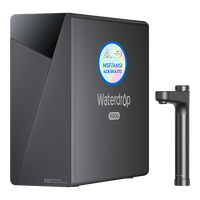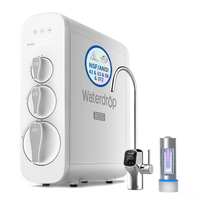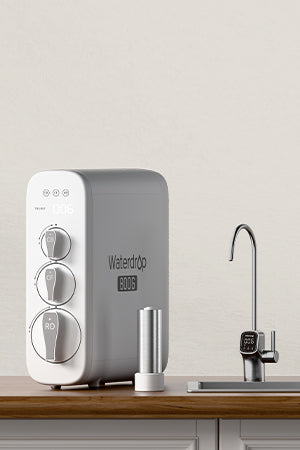Humans are both the persecutor and the victim of water pollution. How can we stop this vicious circle? Check out to see how you can go green with Waterdrop!
Table of Contents
While the world leaders are too busy burying their heads to fight with CO2 emission reduction, they often forget about our basepoint of life—water. Climate change is not only about the increasing temperature,
the melting icebergs, and the about-to-disappear islands. Those seem still far away from our current life. In fact, this climate crisis is affecting everyone's life on a more urgent matter. That is our drinking water.
Indeed. Water pollution is everywhere. We've seen the disastrous sights of oceans with garbage floating around,
the water turning red or green because of the algal blooms. But miles away from the coast, inside our comfortable homes with their fancy water equipment, we may not notice such polluted water has already lurked into our water utilities and ended up in our cups. Horrible, right? But before we go into details about how climate change affects tap water, there is a confession to make. We humans should take almost all the blame.
What do we do exactly?
Water resources are facing a series of threats that are caused by human activity. According to
GreenFacts, "they include pollution, climate change, urban growth, and landscape changes such as deforestation. The removal, destruction or impairment of ecosystems are one of the greatest causes that will influence the water resources." In this article, we are going to list a few aspects that most contribute to water pollution, and how we are affected by this pollution.
Manufacturing
Emissions from factories are released into the air and poured into the water nearby. One of these forms of emissions in the air fall to the ground is
acid rain, which damages streams, lakes, and marshes and can be harmful to fish and other wildlife. The contaminated water can be treated to some degree before it runs into the municipal pipe lines. Still, it is not enough, especially when the local water utility is not useful. Institutions and governments set up rules and guidelines to control water quality, but by far, only a small percentage of chemicals are regulated, and unregulated ones have become a growing concern among the public. A variety of pharmaceutical products, such as painkillers and antibiotics, are having an impact on water resources above and below ground. Conventional water treatment does not work for many of them.
Agriculture
Agriculture is the single largest user of freshwater resources, consuming a global average of 70% of all surface water supplies, and taking up almost half of the earth's
farmable land. Except for water lost through evapotranspiration, agricultural water is recycled back to surface water and/or groundwater. It results in a net loss of soil due to poor agricultural practices such as the discharge of pollutants and sediment to surface and/or groundwater, and the salinization and waterlogging of irrigated land.
According to
EPA (the United States Environmental Protection Agency), the most common source of agricultural water contamination is soil that is washed off fields. Rainwater carries soil particles (sediment) and dumps them into nearby lakes or streams. Too much sediment can cloud the water, reducing the amount of sunlight that reaches aquatic plants. It can also clog the gills of fish or smother fish larvae.
Domestic water use
Used water is called
sewage or wastewater, and we produce a huge amount of it every day, whether it's through washing dishes, taking showers, or cooking meals. In fact, Americans use an average of 300 gallons of water per day, per household. But all this goes down the drain. Sewage is very often not disposed of properly, which becomes a major problem in developing countries. Untreated sewage water in such areas can pollute the surrounding environment and lead to ailments such as diarrhea. Developed countries such as the U.S. have their own problems, as people may flush chemical and pharmaceutical substances down the toilet. When people are ill, sewage often carries harmful viruses and bacteria into the environment. This can cause health problems.
Garbage
Solid waste in the form of trash, litter, and garbage often ends up in these surface waters, because surface waters collect in low-lying areas, anything that is dropped or blown into a watershed can eventually reach a drainageway. In urban areas, trash and litter often are transported by stormwater runoff. In both urban and rural areas, these items sometimes are illegally dumped directly into a waterbody or wetland, or deposited along riverbanks or lakeshores. Trash also comes from people who fish or participate in other forms of water-related recreation. Regardless of source or type, trash is a form of water pollution.
According to
Water Encyclopedia, the most common litter in U.S. streams is household trash, including plastic cups, plastic bags and wrapping materials, fast-food wrappers, plastic bottles, and other plastic containers. Plastics can be especially hazardous to wildlife. Depending on their form they can either be ingested, causing internal organ failure, or they can cause a slow strangulation. *
How does climate change lead to even worse water pollution?
PSR (Physicians for social responsibility) has published a report saying that climate change actually contaminates water because it makes intense heavy downpours, droughts, and rising water temperatures more common. Bacteria and viruses may thrive in these conditions, and they may come into the human body through drinking water and damage people's health. Water runoff carries animal wastes, pesticides, and fertilizers in rural areas, while in cities, it picks up both pollutants and wastewater. This may result in untreated sewage to flow into drinking and recreational water sources.
How can we remove it?
It takes much longer to clean up polluted water bodies than it does for pollution to occur in the first place. Therefore, we have to pay attention to protecting our water resources. In many cases, the clean-up takes longer than 10 years. Underground water is less easily polluted, but cleaning it is more expensive and takes longer. However, there are still many ways to prevent water pollution.
- Collect all the oils and fats produced from cooking and throw them away with solid waste. In this way, they won't be put back into the environment directly with water.
- Don't dispose of household chemicals or flush pills, liquid, or powder medications down the sink or toilet. Such water cannot be treated.
- Go green. Saving water is an amazing solution to reduce water pollution because this can reduce the amount of sewage. You can do this by, for example, using the dishwasher only when there is a full load.
- Use water purification systems to further filter out impurities. Waterdrop offers a wide range of water treatment solutions to meet your need for healthy drinking water, including fridge, pitcher, and under-sink water filtration systems.
Waterdrop tankless
Reverse Osmosis G3 Water Filtration System is has a good reduction ability. This NSF 58-certified water purifier can effectively remove up to 94% of TDS. It has passed more than 400 tests to certify the elimination of more than 400 contaminants such as chlorine, fluoride, mercury, bisphenol A, formaldehyde, benzene, lead, cadmium, etc.
Water pollution affects all of us. Because water is essential to human life, you must act now if you want to live a healthy life by drinking healthy, pure water. Feel free to
contact us to learn more about our RO system and Waterdrop.








































































